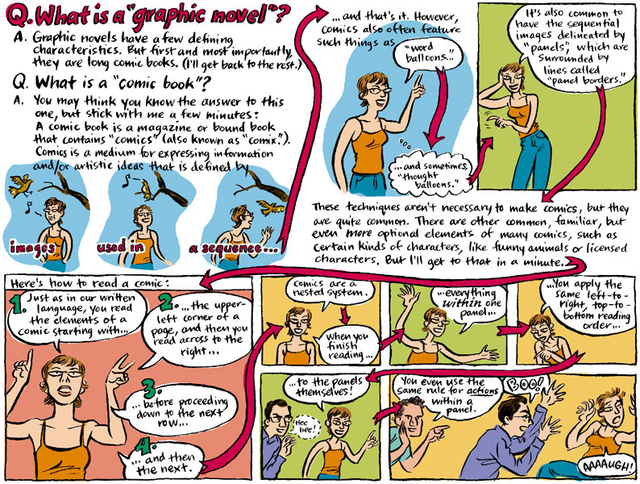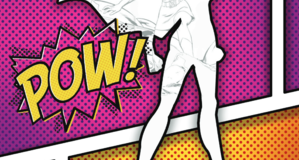Graphic Novels: Preparing for a Mulitmodal and Multiliterate World
By
2014, Vol. 6 No. 08 | pg. 1/5 | »
IN THIS ARTICLE
KEYWORDS
Graphic novels have become increasingly popular in the classroom as a means to engage English language learners (ELL) in new ways (Christensen, 2007). The accessible and diverse content of graphic novels can inspire critical discussions by encouraging students to become ‘agents’ of their own meaning-making experience (Boatright, 2010). Using both text and sequential art to tell what are often serious, non-fiction narratives, many graphic novels use intelligence and humour to explore sensitive issues of race, social justice, global conflict and war (Christensen, 2007). The wide range of stories and perspectives delivered through this multimodal medium are capable of inspiring a deeper level of engagement for students as they relate the stories to their own experiences (Chun, 2009). In an ever-globalizing world, in which the literacy experiences of students, as well as their cultural, social, linguistic, and technological backgrounds, are both diverse and evolving, the use of graphic novels as a pedagogical tool offers various benefits. As such, this paper addresses the question of how the socially diverse material depicted in graphic novels can be used to encourage ELL students and reluctant readers to draw from their own experiences, perspectives, and multiliteracies to construct meaning and participate in ‘critical literacy experiences.’  Image © dw-wp.com English language teachers have an opportunity to introduce students to a form of literature uniquely placed between the old and the new and offering perspectives not embraced by traditional literary discourse. Offering diversity not only in content but also in reading practice, graphic novels can be a more accessible and therefore less intimidating way to experience literature than the traditional novel. As Chun (2009) explains, “the teaching of critical literacy can take place while students develop literacy skills through their engagement with these texts so that they will be better equipped to deal with more traditional texts” (p. 146). In addition to preparing students for more traditional forms of reading, this form of literature can also be used as a means to diversify the types of text and meaning making processes that are emerging with new technologies. With today’s rapid expansion of technology, literacy has become what Leu (2000) refers to as deictic. Leu et al. (2011) explain that “the meaning of literacy rapidly and continuously changes as new technologies for information and communication continuously appear online and new social practices of literacy quickly emerge” (2011, p. 6). Though not an obvious pedagogic solution to technology’s influence on literacy, Coiro (2003) points out that, like graphic novels, web-based texts are typically nonlinear, interactive, and inclusive of multiple media forms. “Each of these characteristics affords new opportunities while also presenting a range of challenges that require new thought processes for making meaning” (2003, p. 459). This paper first addresses how literacy is changing with changes in technology and social practices. Graphic novels, as a print-based medium, meet some of the changing needs of literacy instruction while also addressing three propositions presented by Cummins (2011) for promoting literacy development among immigrant and minority students in actual classroom practice. In addressing these literacy needs, this paper explores how graphic novels can help teachers to involve all students in a critical literacy experience while nurturing the needs of ELL students and reluctant readers simultaneously. How Literacy is ChangingLiteracy is no longer considered a skill that is learned entirely in childhood, in the context of formal school instruction (Organisation for Economic Cooperation and Development [OECD], 2013). Rather, it is viewed as “an expanding set of knowledge, skills and strategies that individuals build on throughout life in various contexts, through interaction with their peers and the wider community” (2013, p. 9). The definition of literacy and the multimodal ways in which it is practiced continuously evolves to meet the demands of the societies in which we live (New London Group, 1996). Technology and the Internet combine to accelerate these developing literary practices. As Cull (2011) asserts, “reading is a cultural activity that has undergone profound changes since its inception” (para 10) and the pace of this ongoing transformation is not slowing. These rapidly evolving practices, however, are making traditional literacy pedagogy, which promotes conventional linear text, insufficient. Concerned with the misalignment between emerging literacy practice and public policy and instruction, Lue et al. (2011) suggest that it is because we are in a time of such transition between conventional print and on-screen reading that this misalignment exists. The authors caution that regardless of the cause, “the misalignments appear to have serious consequences for our youth” (2011, p. 8). These consequences most seriously affect those who do not thrive in the institutional discourse, and/or do not have access to print and technology literature at home. ELL and minority students are the most likely to fit into one or both of these categories. The changing social and cultural realities of literacy, and the imbalanced distribution of technology that enables such practices, thus require that we change the way we approach literacy education. Concerned with current literacy instruction and its limited concern for comprehension of the new literacies of the Internet, Coiro (2003) states, “The Internet, in particular, provides new text formats, new purposes for reading, and new ways to interact with information that can confuse and overwhelm people taught to extract meaning from only conventional print” (p. 458). Chun (2009) furthers this argument stating that because of, “the increasingly complex delivery systems of information in our globalized societies, it follows that the more students are exposed to and grounded in multiple modes of representation, the more they would appear to have a chance to succeed in school and beyond” (p. 146). The process of integrating basic online reading comprehension skills into the current curriculum has been especially slow in some communities. In many cases this may be due to lack of technology in schools and individual classrooms. But Lue et al. (2011) suggest that this may also be due in part to “a basic reluctance to venture beyond the touchstone of our field, the book” (p. 11). While the use of graphic novels may not be able to compensate wholly for limited access to computers and other technologies, they do offer an alternative way of interacting with print-based text so as to help prepare students for the multiple texts they will encounter in their personal and professional lives. Unlike conventional novels, the graphic novel is polysemic, requiring readers to recognize the notions of time, intertextuality, visual literacy, and hypertextuality (Cromer & Clark, 2013). This cross-discursive literacy experience can benefit all students, and, as Chun (2009) points out, the added benefit for ELL students is that much of the language in a graphic novel is contextualized, acting as a support system guiding the reader through the language learning process.Continued on Next Page » Suggested Reading from Inquiries Journal
Inquiries Journal provides undergraduate and graduate students around the world a platform for the wide dissemination of academic work over a range of core disciplines. Representing the work of students from hundreds of institutions around the globe, Inquiries Journal's large database of academic articles is completely free. Learn more | Blog | Submit Latest in Education |


















